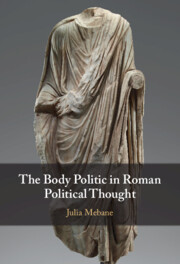The Body Politic in Roman Political Thought
How did Roman writers use the metaphor of the body politic to respond to the downfall of the Republic? In this book, Julia Mebane begins with the Catilinarian Conspiracy in 63 BCE, when Cicero and Catiline proposed two rival models of statesmanship on the senate floor: the civic healer and the head of state. Over the next century, these two paradigms of authority were used to confront the establishment of sole rule in the Roman world. Tracing their Imperial afterlives allows us to see how Romans came to terms with autocracy without ever naming it as such. In identifying metaphor as an important avenue of political thought, the book makes a significant contribution to the history of ideas. This title is part of the Flip it Open Programme and may also be available Open Access. Check our website Cambridge Core for details.
- Adopts the novel approach of using metaphor as source of political thought
- Sheds new light on the transition from the Republic to Empire
- Provides unique perspective on the intellectual culture of the Roman world
Reviews & endorsements
'Mebane argues eloquently and eruditely that the brilliant distortions of the res publica in the first century BCE were too effective to allow any self-governance. … Recommended.' A. J. Papalas, CHOICE
Product details
February 2024Hardback
9781009389297
264 pages
235 × 159 × 20 mm
0.53kg
Available
Table of Contents
- Introduction
- Chapter 1. The Divided Body Politic
- Chapter 2. The Sick Body Politic
- Chapter 3: The Augustan Transformation
- Chapter 4: Julio-Claudian Consensus and Civil War
- Chapter 5: Addressing Autocracy under Nero
- Conclusion.




